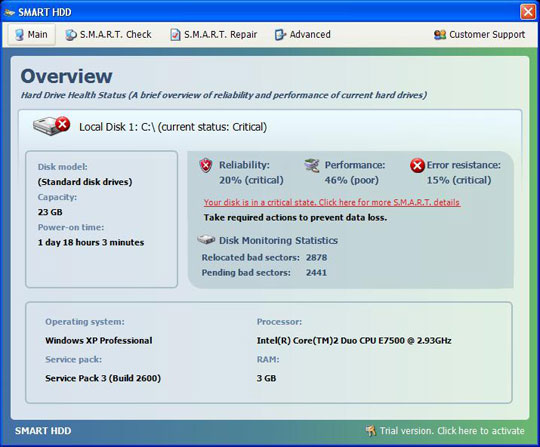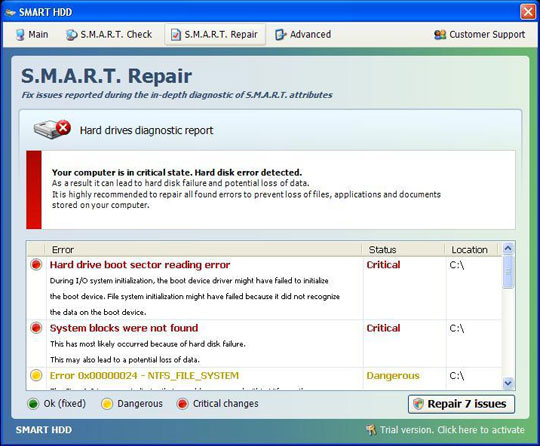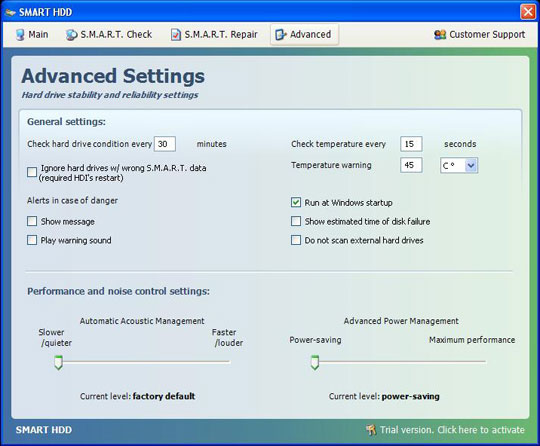TROJ_FAKEFRAG.A
W32/FakeAv.MHSK!tr (Fortinet), a variant of Win32/Kryptik.AEQA trojan (NOD32)
Windows 2000, Windows XP, Windows Server 2003


Threat Type: Trojan
Destructiveness: No
Encrypted: Yes
In the wild: Yes
OVERVIEW
This Trojan arrives on a system as a file dropped by other malware or as a file downloaded unknowingly by users when visiting malicious sites.
It connects to certain URLs. It may do this to remotely inform a malicious user of its installation. It may also do this to download possibly malicious files onto the computer, which puts the computer at a greater risk of infection by other threats.
It deletes the initially executed copy of itself.
It displays fake alerts that warn users of infection. It also displays fake scanning results of the affected system. It then asks for users to purchase it once scanning is completed. If users decide to purchase the rogue product, users are directed to a website asking for sensitive information, such as credit card numbers.
TECHNICAL DETAILS
Arrival Details
This Trojan arrives on a system as a file dropped by other malware or as a file downloaded unknowingly by users when visiting malicious sites.
Installation
This Trojan drops the following copies of itself into the affected system and executes them:
- %System Root%\Documents and Settings\All Users\Application Data\{random}.exe
(Note: %System Root% is the root folder, which is usually C:\. It is also where the operating system is located.)
It drops the following files:
- %Start Menu%\Programs\SMART HDD\SMART HDD.lnk
- %Start Menu%\Programs\SMART HDD\Uninstall SMART HDD.lnk
- %User Profile%\Application Data\Microsoft\Internet Explorer\Quick Launch\SMART_HDD.lnk
- %Desktop%\SMART_HDD.lnk
(Note: %Start Menu% is the current user's Start Menu folder, which is usually C:\Windows\Profiles\{user name}\Start Menu on Windows 98 and ME, C:\WINNT\Profiles\{user name}\Start Menu on Windows NT and C:\Windows\Start Menu or C:\Documents and Settings\{User name}\Start Menu on Windows 2000, XP, and Server 2003.. %User Profile% is the current user's profile folder, which is usually C:\Windows\Profiles\{user name} on Windows 98 and ME, C:\WINNT\Profiles\{user name} on Windows NT, and C:\Documents and Settings\{user name} on Windows 2000, XP, and Server 2003.. %Desktop% is the current user's desktop, which is usually C:\Windows\Profiles\{user name}\Desktop on Windows 98 and ME, C:\WINNT\Profiles\{user name}\Desktop on Windows NT, and C:\Documents and Settings\{User Name}\Desktop on Windows 2000, XP, and Server 2003.)
It drops the following non-malicious files:
- %System Root%\Documents and Settings\All Users\Application Data\{random}
- %System Root%\Documents and Settings\All Users\Application Data\-{random}
- %System Root%\Documents and Settings\All Users\Application Data\-{random}r
(Note: %System Root% is the root folder, which is usually C:\. It is also where the operating system is located.)
It creates the following folders:
- %Start Menu%\Programs\SMART HDD
(Note: %Start Menu% is the current user's Start Menu folder, which is usually C:\Windows\Profiles\{user name}\Start Menu on Windows 98 and ME, C:\WINNT\Profiles\{user name}\Start Menu on Windows NT and C:\Windows\Start Menu or C:\Documents and Settings\{User name}\Start Menu on Windows 2000, XP, and Server 2003.)
Other System Modifications
This Trojan adds the following registry keys:
HKEY_LOCAL_MACHINE\SOFTWARE\Microsoft\
ESENT\Process\{random}
HKEY_LOCAL_MACHINE\SOFTWARE\Microsoft\
ESENT\Process\{random}\
DEBUG
It adds the following registry entries:
HKEY_CURRENT_USER\Software\Microsoft\
Internet Explorer\Main
Use FormSuggest = "Yes"
HKEY_CURRENT_USER\Software\Microsoft\
Windows\CurrentVersion\Internet Settings
WarnOnZoneCrossing = "0"
HKEY_CURRENT_USER\Software\Microsoft\
Windows\CurrentVersion\Internet Settings
WarnonBadCertRecving = "0"
HKEY_CURRENT_USER\Software\Microsoft\
Windows\CurrentVersion\Internet Settings
CertificateRevocation = "0"
HKEY_LOCAL_MACHINE\SOFTWARE\Microsoft\
ESENT\Process\{random}\
DEBUG
Trace Level = ""
It modifies the following registry entries:
HKEY_CURRENT_USER\Software\Microsoft\
Windows\CurrentVersion\Internet Settings\
Zones\3
1601 = "0"
(Note: The default value data of the said registry entry is 1.)
HKEY_CURRENT_USER\Software\Microsoft\
Windows\CurrentVersion\WinTrust\
Trust Providers\Software Publishing
State = "23e00"
(Note: The default value data of the said registry entry is 23c00.)
Download Routine
This Trojan connects to the following malicious URLs:
- {BLOCKED}tacar.com
- {BLOCKED}evud.com
- {BLOCKED}oneca.com
- {BLOCKED}reator.com
- {BLOCKED}adebima.com
- {BLOCKED}adebima.com
Other Details
This Trojan deletes the initially executed copy of itself
Rogue Antivirus Routine
This Trojan displays the following fake alerts:
It displays fake alerts that warn users of infection. It also displays fake scanning results of the affected system. It then asks for users to purchase it once scanning is completed. If users decide to purchase the rogue product, users are directed to the following website asking for sensitive information, such as credit card numbers:
- http://{BLOCKED}tacar.com/support/go.php
- http://{BLOCKED}evud.com/support/go.php
- http://{BLOCKED}oneca.com/support/go.php
- http://{BLOCKED}reator.com/support/go.php
- http://{BLOCKED}adebima.com/support/go.php
SOLUTION
Step 1
For Windows XP and Windows Server 2003 users, before doing any scans, please make sure you disable System Restore to allow full scanning of your computer.
Step 2
Scan your computer with your Trend Micro product and note files detected as TROJ_FAKEFRAG.A
Step 3
Restart in Safe Mode
Step 4
Delete this registry key
Important: Editing the Windows Registry incorrectly can lead to irreversible system malfunction. Please do this step only if you know how or you can ask assistance from your system administrator. Else, check this Microsoft article first before modifying your computer's registry.
- In HKEY_LOCAL_MACHINE\Software\Microsoft\ESENT\Process
- {random}
- {random}
Step 5
Delete this registry value
Important: Editing the Windows Registry incorrectly can lead to irreversible system malfunction. Please do this step only if you know how or you can ask assistance from your system administrator. Else, check this Microsoft article first before modifying your computer's registry.
- In HKEY_CURRENT_USER\Software\Microsoft\Internet Explorer\Main
- Use FormSuggest = "Yes"
- Use FormSuggest = "Yes"
- In HKEY_CURRENT_USER\Software\Microsoft\Windows\CurrentVersion\Internet Settings
- WarnOnZoneCrossing = "0"
- WarnOnZoneCrossing = "0"
- In HKEY_CURRENT_USER\Software\Microsoft\Windows\CurrentVersion\Internet Settings
- WarnonBadCertRecving = "0"
- WarnonBadCertRecving = "0"
- In HKEY_CURRENT_USER\Software\Microsoft\Windows\CurrentVersion\Internet Settings
- CertificateRevocation = "0"
- CertificateRevocation = "0"
Step 6
Restore this modified registry value
Important: Editing the Windows Registry incorrectly can lead to irreversible system malfunction. Please do this step only if you know how or you can ask assistance from your system administrator. Else, check this Microsoft article first before modifying your computer's registry.
- In HKEY_CURRENT_USER\Software\Microsoft\Windows\CurrentVersion\Internet Settings\Zones\3
- From: 1601 = "0"
To: 1601 = "1"
- From: 1601 = "0"
- In HKEY_CURRENT_USER\Software\Microsoft\Windows\CurrentVersion\WinTrust\Trust Providers\Software Publishing
- From: State = "23e00"
To: State = "23c00"
- From: State = "23e00"
Step 7
Search and delete this folder
- %Start Menu%\Programs\SMART HDD
Step 8
Search and delete these files
- %Desktop%\SMART_HDD.lnk
- %System Root%\Documents And Settings\All Users\Application Data\{random}
- %System Root%\Documents And Settings\All Users\Application Data\-{random}
- %System Root%\Documents And Settings\All Users\Application Data\-{random}r
- %User Profile%\Application Data\Microsoft\Internet Explorer\Quick Launch\SMART_HDD.lnk
Step 9
Restart in normal mode and scan your computer with your Trend Micro product for files detected as TROJ_FAKEFRAG.A. If the detected files have already been cleaned, deleted, or quarantined by your Trend Micro product, no further step is required. You may opt to simply delete the quarantined files. Please check this Knowledge Base page for more information.
Did this description help? Tell us how we did.





